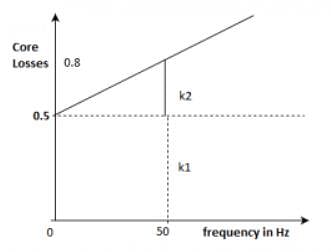Test: Transformer Losses and Efficiency - Electrical Engineering (EE) MCQ
10 Questions MCQ Test Electrical Machines for Electrical Engg. - Test: Transformer Losses and Efficiency
The efficiency of a 20 KVA, 2000/200 V, single phase transformer at unity pf is 98%. The total losses at this condition is?
Mutual flux ______ at the lagging loading and it _____ at the leading power factor.
| 1 Crore+ students have signed up on EduRev. Have you? Download the App |
The full load voltage drop in a 1-phase transformer is 2% and 4% respectively due to resistance and leakage reactance. Then the voltage drop is zero at __________
The efficiency of a 20 KVA, 2000/200 V, single phase transformer at unity pf is 98%. The given total losses at full load is 200 W. The pu resistance is?
It is possible to attain maximum efficiency in a transformer when the ______
Which of the following mentioned losses occur in a transformer?
Which of the statements made here are incorrect regarding the transformer?
I. Maximum voltage regulation occurs at the leading p.f.
II. Maximum voltage regulation occurs when load p.f. angle and impedance angle of the leakage impedance are same.
III. V.R. at zero p.f. is always zero.
IV. V.R. of a transformer may be negative at leading p.f.
Which of the statements made here are correct regarding the transformer?
I. Maximum voltage regulation occurs at the leading p.f.
II. Maximum voltage regulation occurs when load p.f. angle and impedance angle of the leakage impedance are same.
III. V.R. at zero p.f. is always zero.
IV. V.R. of a transformer may be negative at leading p.f.
From the above graph of the core losses per cycle is, the eddy losses per phase for a transformer at a operating frequency of 40 Hz is?

The full load voltage drop in a 1-phase transformer is 2% and 4% respectively due to resistance and leakage reactance. Then the voltage drop is maximum at __________
|
35 videos|85 docs|42 tests
|
|
35 videos|85 docs|42 tests
|

















